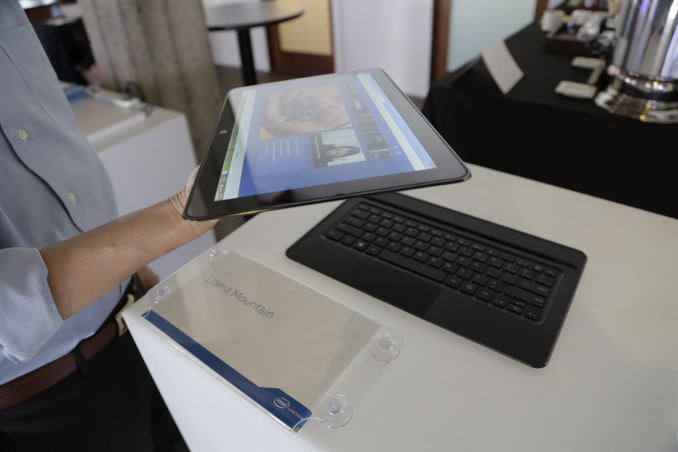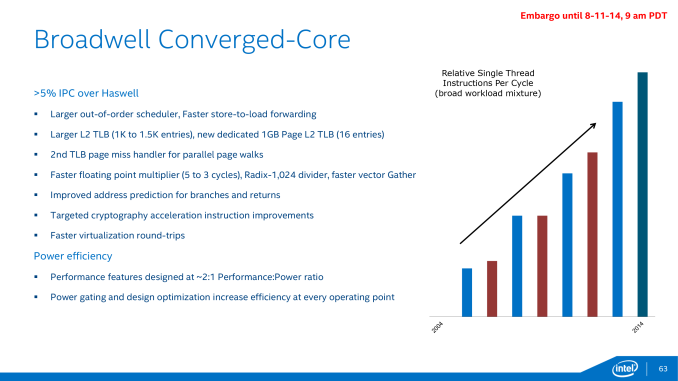Intel Broadwell Architecture Preview: A Glimpse into Core M
by Ryan Smith on August 11, 2014 12:01 PM ESTClosing Thoughts
Wrapping up our preview of the Broadwell architecture and Intel’s Core M processor, the bulk of Intel’s presentation and focus today is on the latter, so that is where we’ll start.
Core M is not a make-or-break product for Intel, but none the less it is a very important one. Mobile devices – be it tablets, slates, transformers, 2-in-1s etc – are continuing to increase in popularity, and as we’ve seen with ARM based tablets so far they form a market that has continued to grow and continued to erode the x86 laptop market that Intel has dominated for so long. Though laptops as a category are not going anywhere any time soon, their erosion means that Intel needs to get into mobile devices if they want to maintain their sales and their stature. To that end it’s not too late for Intel to break into this market and turn things around, but if they’re going to succeed then they need to make their move sooner or later, and this is where Core M fits in.
It’s telling then that while Intel is going after this market with a Core architecture, they are doing so under a different Core brand. Core M doesn’t just represent a new low powered Core CPU, but in Intel’s eyes is another product entirely. One that is so different that it does away with the Core i3/i5/i7 convention entirely and gets its own brand name and own product numbers. Core M is still Core, but it is nearly unrecognizable compared to the Core of even 4 years ago.
As far as the Core M product is concerned then, while Intel’s plans are grand they are not without merit. Backed by Intel’s new 14nm process and the Broadwell architecture, Core M looks like it should finally resolve the issues that dogged even Haswell-Y by bringing down power consumption even further while improving on Intel’s already strong performance, and getting the resulting processor in an SoC small enough to be usable in even the thinnest mobile devices. In fact from a technical perspective there’s little reason to doubt Core M; we’ll still have to wait to see just how good the resulting retail products are, but there shouldn’t be any technical reason for why it can’t be put into a mobile device comparable to today’s 10”+ tablets. Intel’s own Llama Mountain reference design can vouch for that much, showcasing the viability of Core M in a 12.5” tablet that’s just 7.2mm thick.
Intel's Llama Mountain, a Core M form factor reference design
More likely what will determine Core M’s fate and Intel’s ability to completely break into the mobile device market will be pricing. Intel’s profit margins are somewhat legendary in the computer industry, and a big part of that profitability has come from the high prices Intel has enjoyed from products such as their Core processors. Core M, like the other Cores before it, will still be an upscale product – a higher priced, higher performance alternative to Intel’s mass-market Atom processors. And while that makes plenty of sense on paper, in the real world Intel has to face the AllWinners and other ARM vendors of the world who are happy to sell their ARM SoCs at significantly lower margins, which can have a knock-on effect even if they can’t compete with Intel on overall performance. At this point it’s far too early to call this, especially when Intel isn’t even discussing Core M pricing at this time, but it’s a subject that Intel will have to consider carefully as “good enough” ARM devices will continue to be the biggest threat to Intel’s position in the CPU market.
Moving on, while today’s release from Intel only offers us a preview of what Intel will be delivering with their Broadwell architecture, what Intel has presented thus far looks to continue Intel’s tradition of relentless execution. As a tick Broadwell is a small but respectable improvement in Intel’s Core architecture, with the expected 5% IPC improvement in-line with previous ticks. For more traditional desktops and laptops it won’t radically change the world, but then it never was meant to. The biggest question for these parts will be whether Broadwell will improve on Haswell’s clockspeeds at all – a clockspeed boost made possible by Intel’s 14nm process – or if we’re going to hold steady similar to what we saw with the last tick, Ivy Bridge.
Meanwhile Broadwell’s GPU improvements are more significant, and in the race to further improve what’s essentially the baseline for PC GPU performance it is always welcome. Furthermore the fact that Intel is now at API feature parity with discrete GPUs is a big deal for Intel and it is a big deal for iGPUs as a whole. What we still want to see is more performance; a single slice seems just about right for Core M, but if we’re talking about larger laptop and desktop parts it would be very nice to see something akin to GT3 become baseline, especially with the die size savings Intel will be seeing from the 14nm process.
Finally, from here the rest of Intel’s 2014 should be rather busy. Next month is Intel’s Fall IDF 2014, at which point we expect we’ll be given a deeper look at Broadwell’s architecture. Past that the first Broadwell-Y based Core M processors will be on the shelves for the holidays, and with it our chance to see Broadwell and Intel’s 14nm process in action. However that will also be our only chance to see Broadwell in action this year; while Core M will ship in time for the holidays, the rest of the Broadwell lineup will not appear until 2015.













158 Comments
View All Comments
Hrel - Tuesday, August 12, 2014 - link
". Intel has made it clear that they don’t regress on clockspeeds"lol, they often regress on clockspeeds.
nikolayo - Wednesday, August 13, 2014 - link
This sounds as a distraction meant to divert attention from the fact that Intel is about a year late with 14nm. It seems than the Moore's law will stop working quite soon. I would still bet on Intel being able to implement 10nm but that will likely be the end of the road for the current technology. And there is no clearly visible path beyond that. Not that progress will stop but it may slow down to the pace we observe e.g. in car design and production rather than what we are used to expect in chip design and production.asoltesz - Wednesday, August 20, 2014 - link
Car design and production is being turned upside down by electric cars like Tesla.Apart from the comparisson, you may be right.
lagittaja - Wednesday, August 13, 2014 - link
Honestly. After reading the article. Which was really a good read and huge thanks to Ryan. All I can say is. Amazing. That is all.Oxford Guy - Thursday, August 14, 2014 - link
"Intel’s solution to this problem is both a bit brute force and a bit genius, and is definitely unlike anything else we’ve seen on PC GPUs thus far. Since Intel can’t reduce their idle voltage they are going to start outright turning off the GPU instead;"That qualifies as genius these days? The most obvious method to reduce a GPU's power consumption is to turn it off.
c plus plus - Saturday, August 16, 2014 - link
intel is really amazing and i hope broadwell doubles both gpu and cpu performance with the help of magicMr Pras - Tuesday, August 19, 2014 - link
I liked the comments in this thread but was disturbed by the fan boys. Just because there was an amd marketer here doesn't mean that we should resort to intel worship. At least for me, those discussions are totally moot in this thread.Blaiser - Wednesday, September 17, 2014 - link
Can somebody clarify this for me?Broadwell Core M is supposed to support fanless designs. Will Broadwell-U support fanless as well? Meaning will high end laptops with Broadwell-U be fanless? If not, will Skylake be able to have high end machines be fanless?